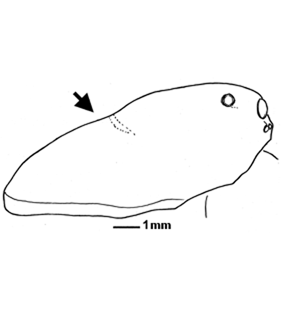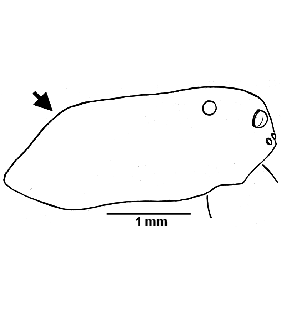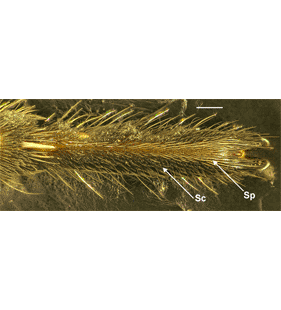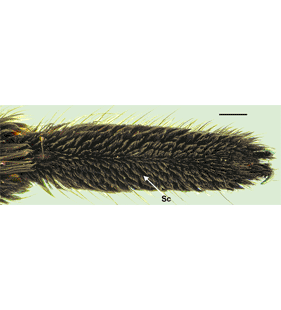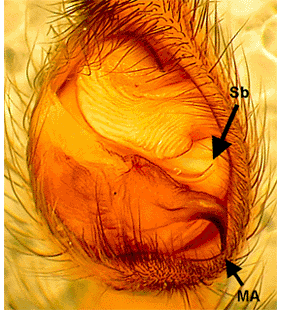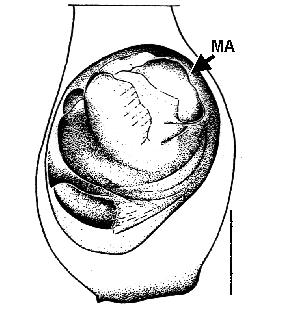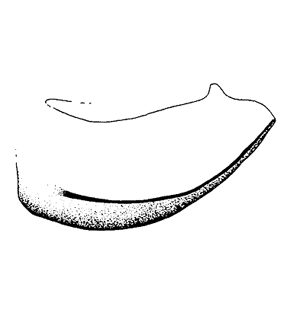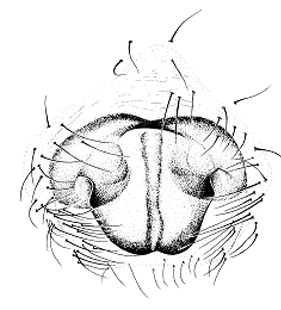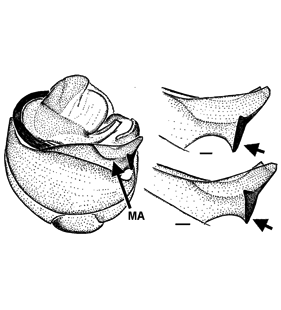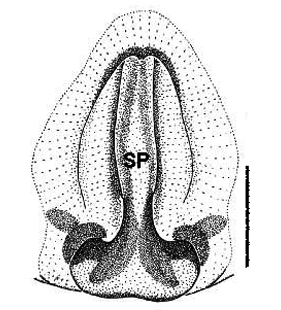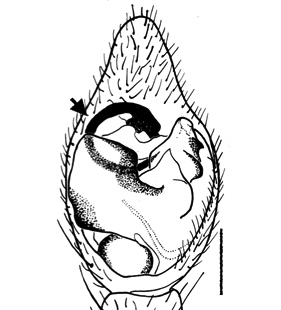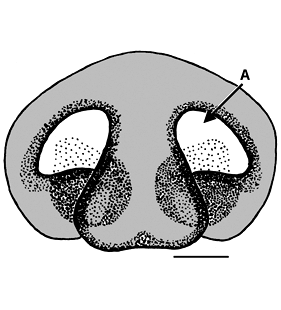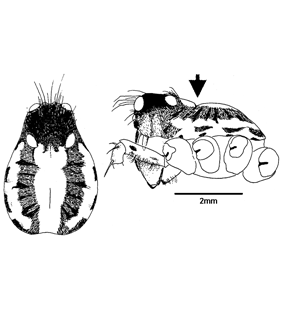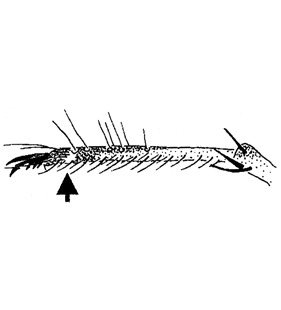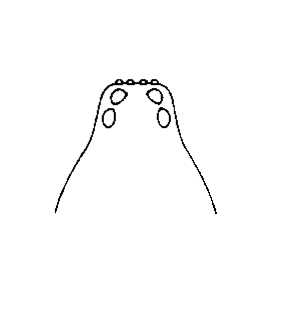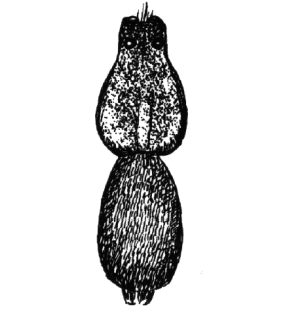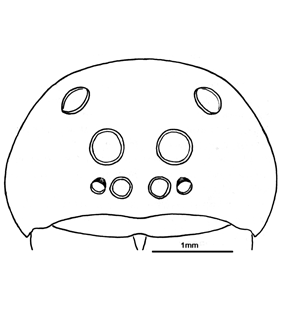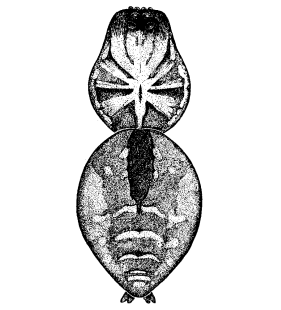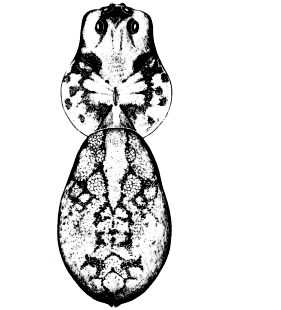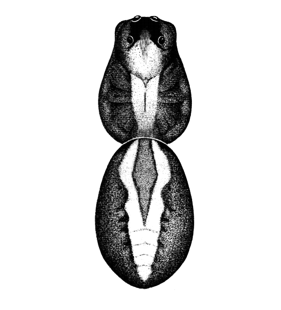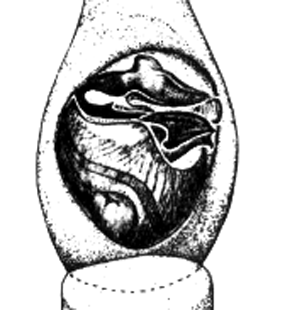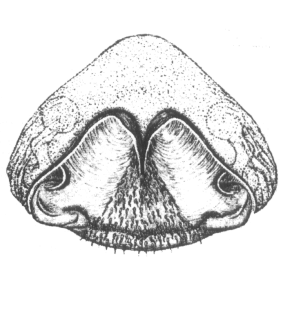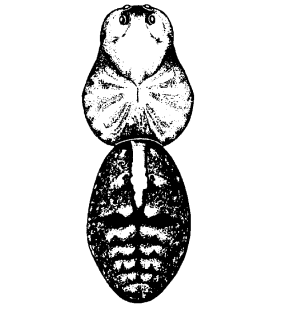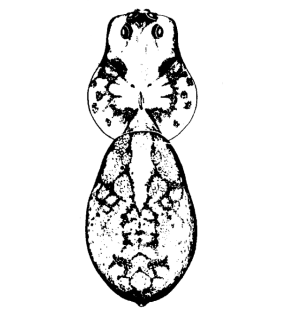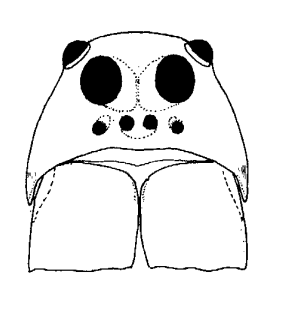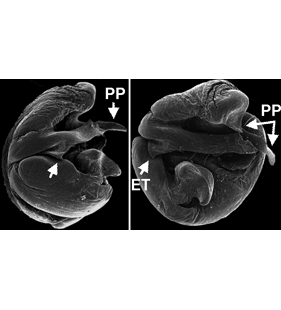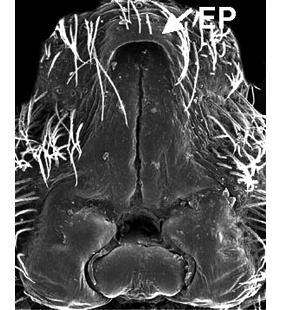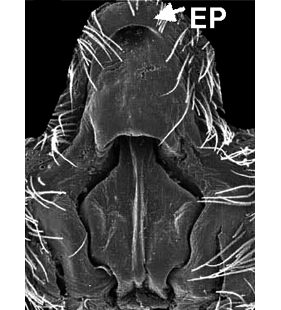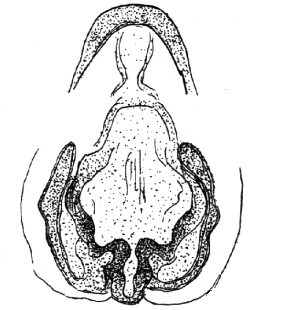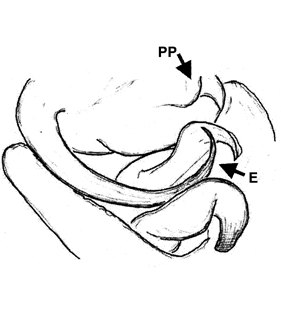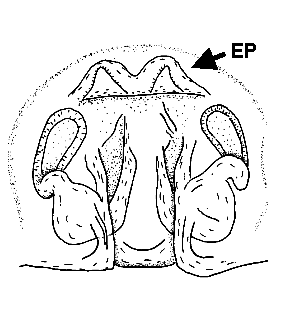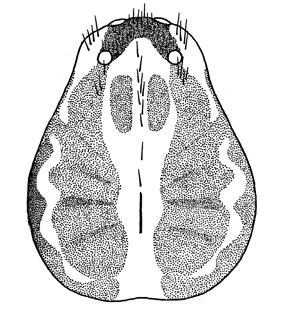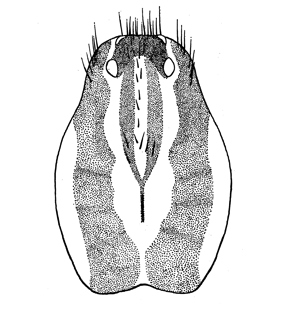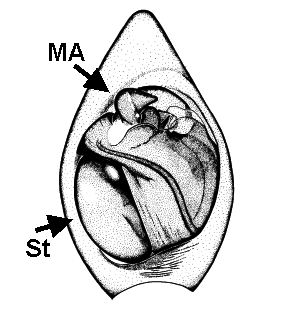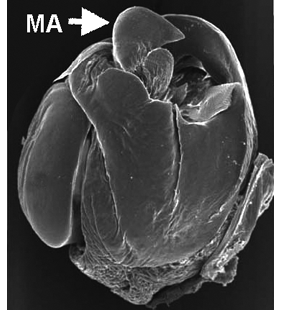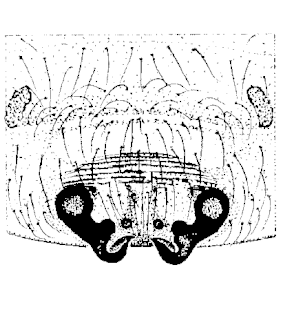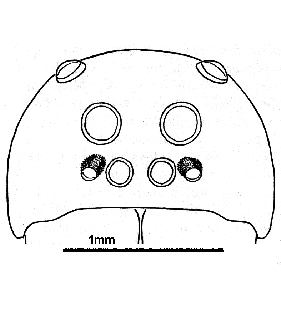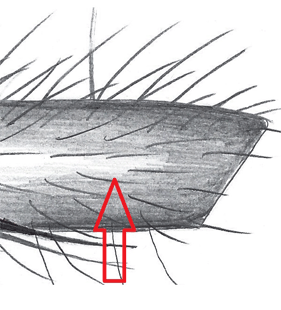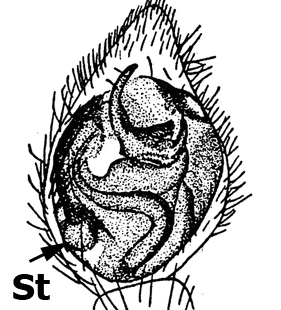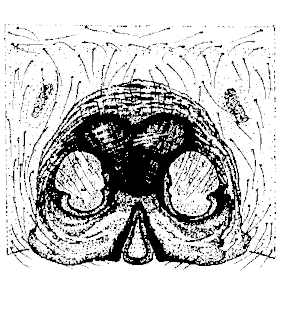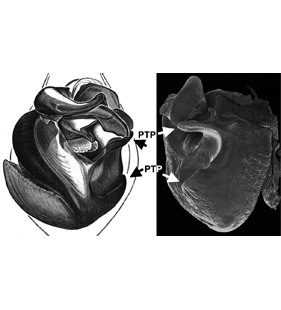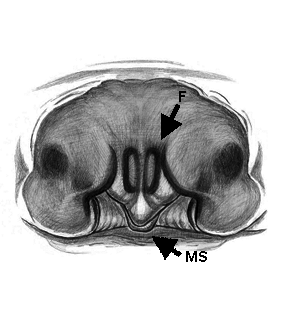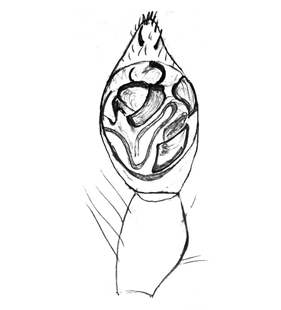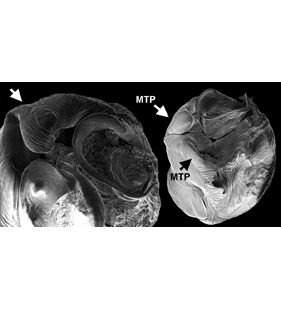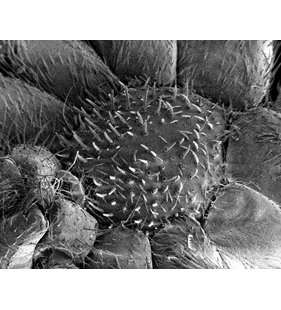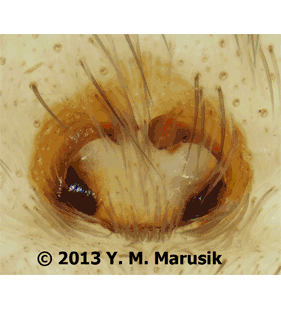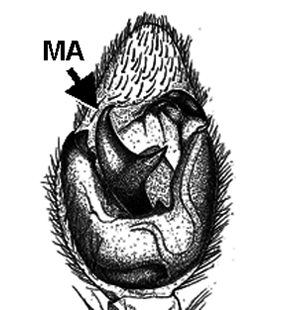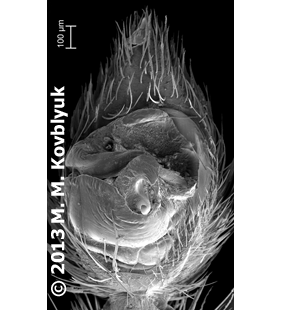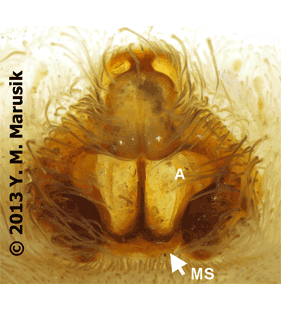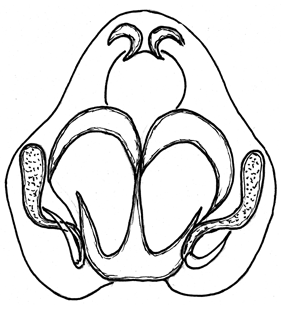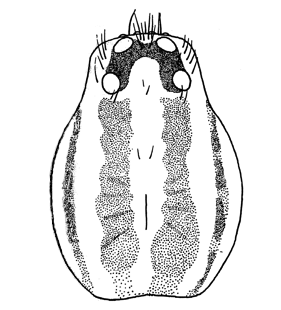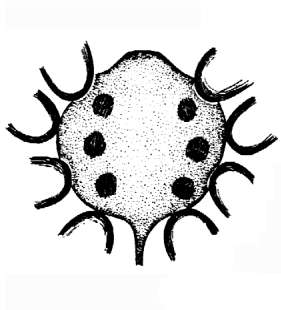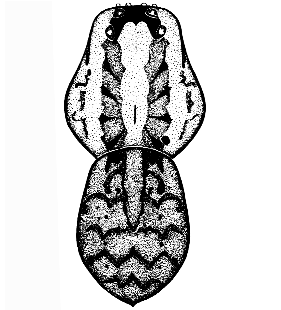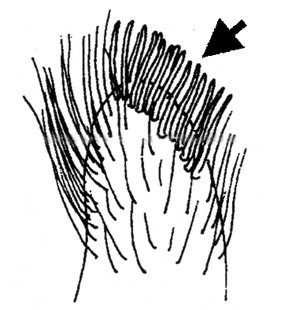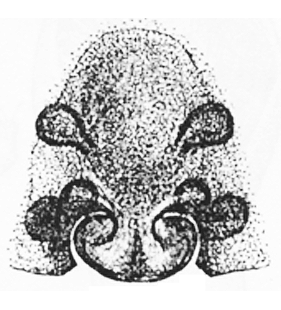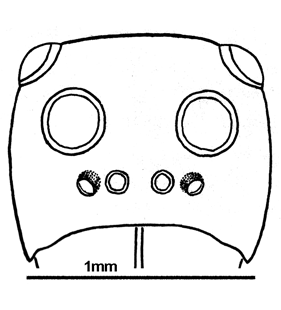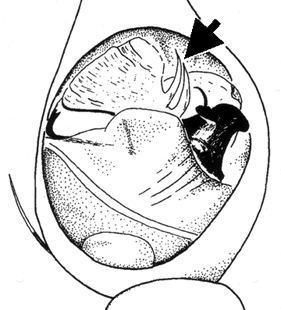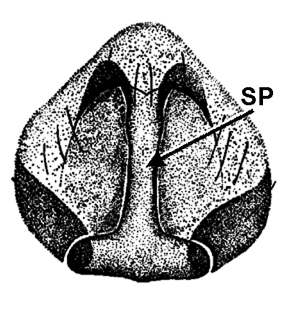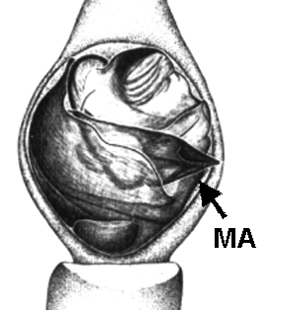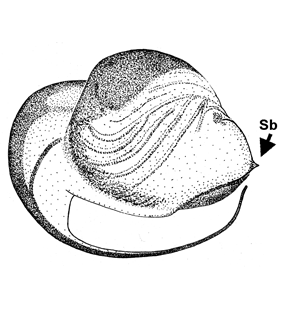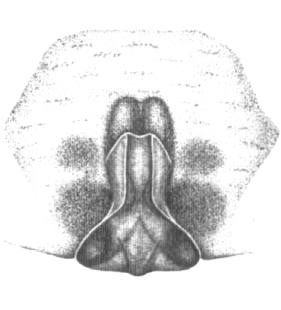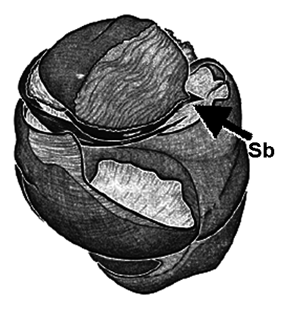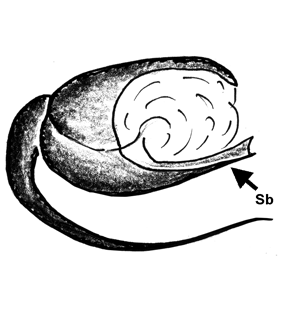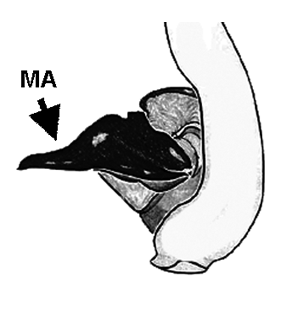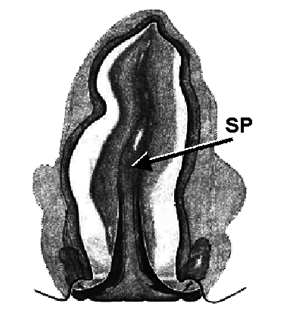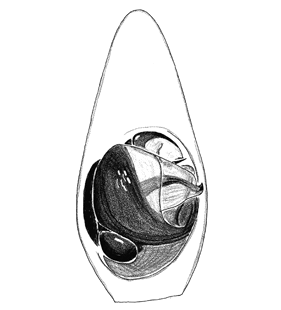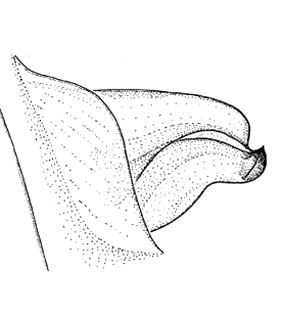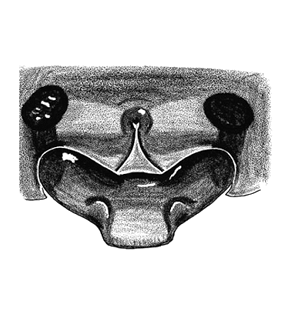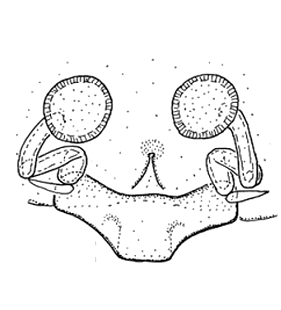Familie Lycosidae Sundevall, 1833
Schlüssel nicht vollständig. Weitere Gattungen sind am Ende aufgelistet. |
Für Fehlermeldungen oder Verbesserungsvorschläge bitte Link folgen: click
|
||||||||||
| 1 |
Prosoma in seitlicher Ansicht mit gleichmässig abfallendem Thoraxteil; hinterer Chelicerenfurchenrand mit 3 Zähnen; grosse bis sehr grosse Spinnen (15-35 mm). Grabende Arten, in tiefen Röhren |
| |||||||||
| - | Prosoma in seitlicher Sicht mit deutlich steilerem Bereich hinter der Fovea; hinterer Chelicerenfurchenrand mit 2 oder 3 Zähnen; kleine bis mittelgrosse Spinnen (< 20 mm). Nicht-grabende Arten (bodenlebend oder in flachen Seidenröhren) |
| |||||||||
| 2 (1) |
Zweite Augenreihe deutlich breiter als die vordere Reihe; vordere Augenreihe rekurv; Tarsen I + II mit Scopulae (Sc) und Stacheln (Sp) |
| |||||||||
| - | Zweite Augenreihe ungefähr gleichbreit wie die vordere Augenreihe; vordere Augenreihe gerade; Tarsen I + II nur mit dichten Scopulae (Sc), keine Stacheln |
| |||||||||
| 3 (2) |
Medianapophyse (MA) des Palpus hakenförmig; embolus-artiger Synembolus (Sb) vorhanden; gestielter Septumteil (SP) der Epigyne deutlich vorhanden, vorne mit einer Erhöhung (PE) |
| |||||||||
| - | Medianapophyse (MA) breit vorstehend; Synembolus fehlt; Septum ohne Stiel. Monotypische Gattung nur aus Andalusien (Spanien) bekannt |
| |||||||||
| 4 (2) |
VMA-Durchmesser /Clypeus-Höhe 1.3-1.6; Medianapophyse (MA) des Palpus mit distalem Vorsprung (Pfeil); medianes Septum (MS) der Epigyne ankerförmig, mit kurzem Stiel am Septum (SP)
Allohogna -> siehe unter Lycosa |
| |||||||||
| - | VMA-Durchmesser /Clypeus-Höhe 0.7; Medianapophyse des Palpus mit proximal-ventral zugespitztem Zahn (Pfeil); Stiel am Septum der Epigyne lang (SP), in der proximalen Hälfte mit dem Atrium der Epigyne verschmolzen |
| |||||||||
| 5 (1) |
Opisthosoma ohne Herzfleck; Palpus mit einer tiefen apikalen Aushöhlung des Tegulums, in der der Embolus liegt (Pfeil); Atrium der Epigyne (A) flach und paarig, farblich kontrastierend (weisslich) zur übrigen Epigynenplatte |
| |||||||||
| - | Opisthosoma mit Herzfleck (manchmal undeutlich); Palpus ohne tiefe apikale Aushöhlung des Tegulums; Atrium der Epigyne (wenn vorhanden) in der gleichen Farbe wie die ganze Epigynenplatte |
||||||||||
| 6 (5) |
Metatarsus I mit 3-4 Paar ventraler Stacheln (neben den apikalen); Tibia I mit 4-6 Paar langer ventraler Stacheln (neben den apikalen); Tarsen aller Beine mit Pseudogelenken (Pfeil, nicht bei allen Arten); Prosoma mit transversaler Einschnürung hinter dem Augenbereich; Körperlänge 5.5-11 mm |
| |||||||||
| - | Metatarsus I mit 2 Paar ventraler Stacheln (neben den apikalen); Tibia I mit 3 oder weniger Paaren langer ventraler Stacheln (neben den apikalen); Tarsus ohne Pseudogelenke; Prosoma ohne transversale Einschnürung; Körperlänge 5-7 mm |
| |||||||||
| 7 (5) |
Pedipalpenpatella weiss bei beiden Geschlechtern; Prosoma vorne schmal, so breit wie der Augenbereich; Körperlänge ≤ 4 mm |
| |||||||||
| - | Pedipalpenpatella nicht weiss; Prosoma vorne deutlich breiter als der Augenbereich; Körperlänge > 4 mm |
| |||||||||
| 8 (7) |
Prosoma ohne helles Mittelband |
| |||||||||
| - | Prosoma mit hellem Mittelband, deutlich gegen dunkle Bereiche abgegrenzt, wenn undeutlich, dann mit V-förmigem Muster |
| |||||||||
| 9 (8) |
Beine deutlich gefleckt oder geringelt; Genitalorgane wie abgebildet; Körperlänge < 15 mm |
| |||||||||
| - | Beine nicht gefleckt oder geringelt; Genitalorgane wie abgebildet; Körperlänge 15-18 mm. Die Typusart kommt endemisch in den französischen und italienischen Alpen (1800-2700 m) vor |
| |||||||||
| 10 (8) |
Tibia I + II mit 4-7 Paar ventraler Stacheln; Beine auffällig lang; dunkle Körperfarbe mit wenig oder kaum erkennbarer Musterung |
||||||||||
| - | Tibia I + II mit 3 oder weniger Paar ventraler Stacheln, wenn 4 oder mehr Paar, dann Körper mit deutlicher, heller Farbmusterung |
||||||||||
| 11 (10) |
Tibia I mit 4-7 Paar ventraler Stacheln; Palea am männlichen Pedipalpus mit zwei Fortsätzen (PP); Embolus dick, meist mit basalem Zahn (ET); nur eine apikale Epigynentasche (EP), diese deutlich schmaler als das mediane Septum; lange Befruchtungsgänge; Körperlänge 6.5-11 mm |
| |||||||||
| - | Tibia I mit 6-7 Paar ventraler Stacheln; Palea am männlichen Pedipalpus mit schwach entwickelten beulenartigen Fortsätzen (PP); Embolus dünn (E); die paarigen apikalen Epigynentaschen (EP) deutlich breiter als das mediane Septum; kurze Befruchtungsgänge; Körperlänge 7-10 mm |
| |||||||||
| 12 (10) |
Mittelband des Prosoma mit dunkler Begrenzung (manchmal undeutlich) |
||||||||||
| - | Mittelband des Prosoma ohne dunkle Begrenzung |
||||||||||
| 13 (12) |
Kopfteil mit 2 dunklen parallelen Streifen in der Mitte; VMA > VSA; Bein I beim Männchen oft verdunkelt; Körperlänge 7-18 mm |
| |||||||||
| - | Kopfregion mit gegabelter dunkler Zeichnung; VMA ≥ VSA; Bein I beim Männchen nie verdunkelt; Körperlänge 2.5-9 mm. Die meisten Arten leben in Feuchtgebieten |
| |||||||||
| 14 (13) |
VMA > VSA; Prosomalänge > 3 mm; Medianapophyse (MA) des Pedipalpus klein, am distalen Ende des Tegulums; Medianapophyse ohne Zähne; Subtegulum (St) > ½ Tegulumlänge; prolateraler Stachel an Tibia I fehlt beim Weibchen |
| |||||||||
| - | VMA ± gleichgross wie VSA; Prosomalänge < 3 mm; Medianapophyse (MA) des Pedipalpus gross (C-förmig), nimmt fast ein Drittel des Bulbus ein; Medianapophyse mit 1-2 Zähnen; Subtegulum (St) < ½ Tegulumhöhe; prolateraler Stachel an Tibia I beim Weibchen vorhanden |
| |||||||||
| 15 (12) |
Tegulum des Pedipalpus mit Fortsatz, Epigyne wie in Ziffer 16 (für Wadicosa oder Bogdocosa) |
||||||||||
| - | Tegulum des Pedipalpus ohne Fortsatz, Epigyne anders |
||||||||||
| 16 (15) |
Tegulum mit zwei prolateralen Fortsätzen (PTP); Sternum bei beiden Geschlechtern ohne Stacheln; Epigyne mit medianem Septum (MS), nach hinten spitz zulaufend; Epigyne vorne mit zwei getrennten Fovea (F); Körperlänge 6-7 mm |
| |||||||||
| - | Tegulum mit zwei medianen Fortsätzen (MTP); Sternum beim Männchen mit zahlreichen Stacheln; Epigyne mit medianem Septum (MS), nach hinten breiter werdend; Epigyne ohne Atrium oder abgetrennte Fovea; Körperlänge 5.5-8.2 mm. Monotypische Gattung aus dem südöstlichen Teil des europäischen Russland (Gebiet um Astrachan) |
| |||||||||
| 17 (15) |
Medianapophyse (MA) des Pedipalpus massig, nimmt die Hälfte oder mehr der Bulbuslänge ein; Embolus haarförmig (E); medianes Septum der Epigyne klein, dreieckig und depress (eine europäische Art, siehe Hinweis unter T. brunhesi) |
| |||||||||
| - | Medianapophyse (MA) des Pedipalpus deutlich weniger als halbe Länge des Bulbus; Embolus anders; medianes Septum der Epigyne grösser und nicht depress |
||||||||||
| 18 (17) |
Palea des Palpus mit kräftigem prolateralen Fortsatz (PP); Epigyne vorne mit paariger Tasche; paariges Atrium der Epigyne tief (A); enges, ankerförmiges medianes Septum (MS); Tibia I + II mit 2 Paar ventraler Stachel (ohne die apikalen); Körperlänge 5.7-8 mm |
| |||||||||
| - | Kopulationsorgane anders |
||||||||||
| 19 (18) |
VMA < VSA; Sternum mit sechs dunklen Flecken; Prosoma mit einem hellen Band in der Mitte und zwei hellen lateralen Bändern; Körperlänge ≤ 5 mm |
| |||||||||
| - | VMA ≥ VSA; Sternum ohne sechs dunklen Flecken; Prosoma anders |
||||||||||
| 20 (19) |
Prosoma vorne viereckig; HMA-Durchmesser / VMA-Durchmesser ≥ 3.6; Cymbium des Palpus mit zwei parallelen apikalen Reihen flacher Setae (Pfeil); Kopulationsorgane wie abgebildet; Körperlänge 3-8 mm |
| |||||||||
| - | Prosoma anders; HMA-Durchmesser / VMA-Durchmesser ≤ 2.8; Kopulationsorgane anders |
||||||||||
| 21 (20) |
Seiten des Kopfes vertikal; VMA-Durchmesser / Clypeus-Höhe ≤ 0.7; kleine bis mittelgrosse Arten; Körperlänge 4-10 mm |
| |||||||||
| - | Seiten des Kopfes schräg; VMA-Durchmesser / Clypeus-Höhe ≥ 0.7; mittelgrosse bis grosse Arten |
| |||||||||
| 22 (21) |
Hinterer Chelicerenfurchenrand mit 3 Zähnen |
||||||||||
| - | Hinterer Chelicerenfurchenrand mit 2 Zähnen |
||||||||||
| 23 (22) |
Opisthosoma kugelförmig; hintere Spinnwarzen deutlich verlängert (Pfeil); Palea des Palpus mit zwei sichelförmigen Fortsätzen (Pfeil); Epigyne mit sehr schmalem medianen Septum (MS), und kurzem gestielten Septumteil (SP); Körperlänge 12-18 mm |
| |||||||||
| - | Opisthosoma länglich; hintere Spinnwarzen nicht verlängert; Palea des Palpus mit einem sichelförmigen Fortsatz (Sb, Pfeil); gestieltes Septumteil (SP) der Epigyne lang; Körperlänge 9-25 mm |
| |||||||||
| 24 (22) |
Synembolus (Sb) des Palpus reduziert zu einem spitzen Vorsprung; Medianapophyse (MA) transversal, mit spitzem Zahn an der Spitze; medianes Septum der Epigyne meist anker- oder birnenförmig; Opisthosoma meist mit Herzfleck |
| |||||||||
| - | Synembolus (Sb) gut entwickelt; Kopulationsorgane |
| |||||||||
| 25 (24) |
Länge der massigen Medianapophyse (MA) des Palpus grosser als Tegulumbreite; Epigyne 2.5 mal länger als breit; gestieltes Septumteil (SP) mit Atrium der Epigyne in der vorderen Hälfte verschmolzen; Körperlänge 10-11 mm. Monotypische Gattung, nur von der Krim bekannt |
| |||||||||
| - | Kopulationsorgane anders; Körperlänge 9-12 mm. Nur eine osteuropäische Art im Gebiet |
|
Dieser Schlüssel wurde freundlicherweise von Dmitri Logunov zur Verfügung gestellt.
Die folgenden Gattungen wurden nicht eingefügt, obwohl sie für Europa aufgelistet werden:
- Allocosa umfasst kleine bis mittelgrosse Wolfspinnen warm-gemässigter bis tropischer Gebiete der westlichen Hemisphäre (Dondale & Redner 1990), daher ist das Vorkommen von Allocosa Arten in Europa sehr zweifelhaft. Die besser bekannten europäischen “Allocosa” Arten (z.B. A. fasciiventris) wurden bereits Lycosa zugeordnet (siehe Planas et al. 2013).
- Megarctosa scheint ein jüngeres Synonym von Lycosa (Wunderlich 1984: 23) zu sein. Die einzige europäische Art (M. naccai Caporiacco, 1948) ist die Typusart von Megarctosa, bekannt von nur einem Weibchen und nur vom Typusort (Griechenland); der taxonomisch Status von M. naccai erfordert daher noch eine spezielle Untersuchung.
- Schizocosa ist eine Gattung mit 21 validen Arten, die nur in Nordamerika vorkommen (Dondale & Redner 1990). Die einzige europäische Art, S. krynickii (Thorell, 1875), wurde Alopecosa zugeordnet (siehe die Diskussion bei Logunov 2013). Die Gattung Schizocosa ist somit für Europa zu streichen.
- Trochosula = Hogna (siehe Platnick 2014).
Weitere Gattungen
- 1. Allocosa
- 2. Asiacosa
- 3. Crocodilosa
- 4. Cynosa
- 5. Evippomma
- 6. Halocosa
- 7. Hippasa
- 8. Hyaenosa
- 9. Karakumosa
- 10. Megarctosa
- 11. Orinocosa
